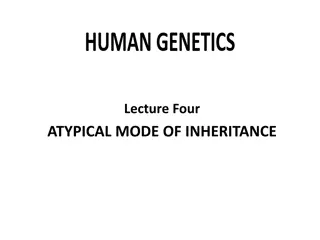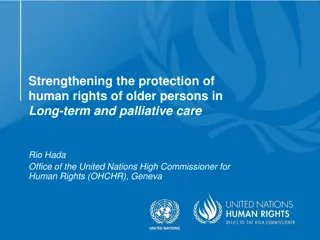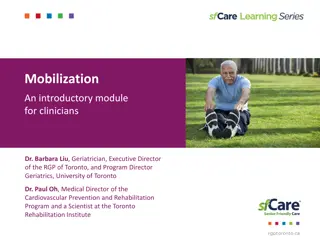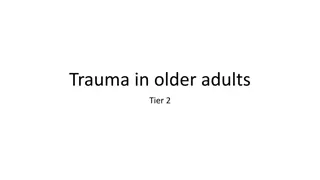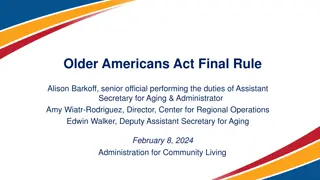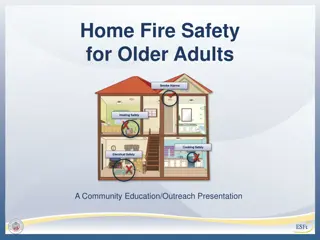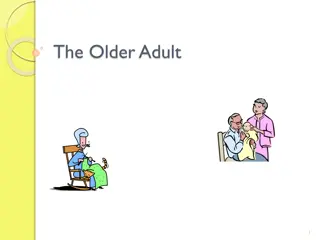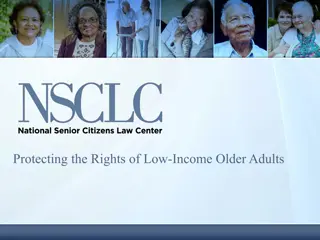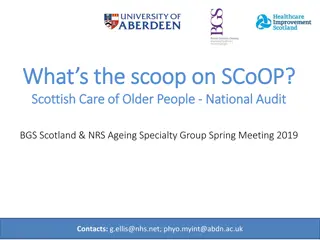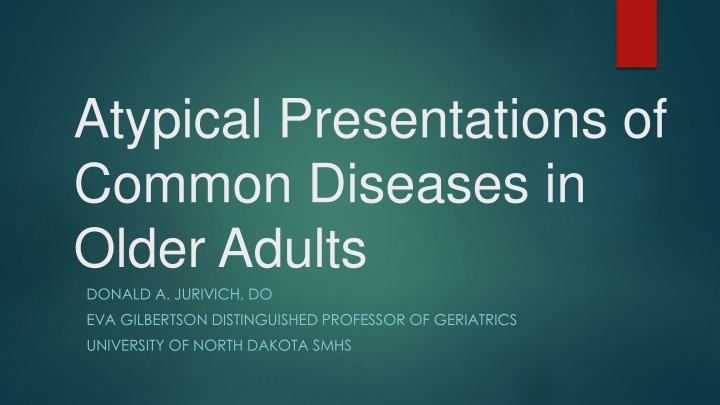
Recognizing Atypical Presentations of Diseases in Older Adults
Learn about how symptoms may differ in older adults, common illnesses that present differently in the elderly, risk factors for atypical presentations, features of atypical presentations, clues to identify them, and the consequences of not understanding them.
Download Presentation

Please find below an Image/Link to download the presentation.
The content on the website is provided AS IS for your information and personal use only. It may not be sold, licensed, or shared on other websites without obtaining consent from the author. If you encounter any issues during the download, it is possible that the publisher has removed the file from their server.
You are allowed to download the files provided on this website for personal or commercial use, subject to the condition that they are used lawfully. All files are the property of their respective owners.
The content on the website is provided AS IS for your information and personal use only. It may not be sold, licensed, or shared on other websites without obtaining consent from the author.
E N D
Presentation Transcript
Atypical Presentations of Common Diseases in Older Adults DONALD A. JURIVICH, DO EVA GILBERTSON DISTINGUISHED PROFESSOR OF GERIATRICS UNIVERSITY OF NORTH DAKOTA SMHS
Goals Report how symptoms may differ in older than younger adults Recognize common illnesses that present differently in old relative to young adults
Usual script for understanding disease Typical collection of signs and symptoms Triad of wild, wet and wobbly for recognizing NPH Pericarditis: sharp chest pain (95%) relieved with sitting or leaning forward, tachycardia, pericardial friction rub.
What is an atypical presentation ? when an older adult presents with a disease state that is missing some of the traditional core features of the illness usually seen in younger patients. May account for 20 50 % of disease presentations in older adults
Who is at risk for atypical presentations ? Increasing age (especially age 85 years or older) Multiple medical conditions ( multi-morbidity ) Multiple medications (or polypharmacy ) Cognitive impairment Residing in a care institution or functional dependency
Atypical presentations usually include one of three features vague presentation of illness e.g., generalized weakness or I hurt all over altered presentation of illness e.g., reflection of chest problems as abdominal discomfort or abdominal issues as upper torso complaints (right shoulder pain with GB disease) Not reporting illness and attributing to old age i.e., under reporting
What are clues for atypical presentation ? Change in Behavior Function Cognition
What are the consequences of not understanding atypical presentations ? Provider perspective: worse outcomes missed diagnoses missed opportunities for treatment
What are the consequences of not understanding atypical presentations ? Patient perspective: Lack of knowledge (eg., MI mistaken for indigestion) Social factors (it will pass, don t bother others) Dependency and Lack of caregiver Lack of transportation, Fear of being hospitalized, Risk of losing independence
Five common disease states in which atypical presentations may be seen Infections Cardiovascular disease Acute abdomen Hyperthyroidism Depression
Infections: general differences Typical Fever Atypical Afebrile Chills Altered mental status Sweats Dehydration
Urinary Tract Infections (UTI) Typical Dysuria Frequency Urgency Suprapubic pain + / - bloody urine Atypical Worsening incontinence Apathetic / Confusion / delirium Increased nocturia Lack of well being / change in function Falls Urinary tract infections in older women: a clinical review. JAMA. 2014 Feb;311(8):844-54
Diagnosis of UTI positive urine culture ( 105 CFU/mL) no more than 2 uropathogens pyuria ( 10 leukocytes/microL or + leukocyte esterase or nitrites* ) WBC casts = upper urinary tract infection * 75% sensitive, 82% specific for UTI
Note Cranberry juice does not prevent or treat UTI s
Pneumonia TYPICAL Fever Cough (dry or productive) Dyspnea Pleuritic pain Chills / Rigors ATYPICAL Non febrile Abdominal pain Confusion Tachypnea + / - Tachycardia
Pneumonia Tests ATYPICAL TYPICAL
Pneumonia signs TYPICAL Fever Increased RR Reduced O2 sat Tachycardia Elevated WBC Elevated CRP (50 100 mg / dL) ATYPICAL Afebrile or 2oF elevation Normal to high normal RR Reduced O2 sat Hypo or hyperactive delirium
Pneumonia in older adults Drivers of tachypnea are reduced with age Respiratory rate may not increase until respiratory failure (low O2, high CO2 or both) Dehydration may preclude sputum production May not auscultate egophony or feel vocal fremitus
COVID19 TYPICAL Fever Sore throat Cough Coryza ATYPICAL Loss of appetite Abdominal discomfort Conjunctivitis Falls / syncope Confusion
Case report 91F who resides in a nursing home with moderate dementia, falls, diabetes, peripheral neuropathy, hypertension and generalized osteoarthritis is found by the nurse at dinner time lying in bed. She is arousable but wants to be left alone. She states that she is not hungry because she has a stomach ache and is tired.
What additional evaluations should the RN do ?
Suggested tests when hypo active delirium is suspected Vitals signs, including orthostasis, temperature, pulse ox, and glucometer Confusion Assessment Method Request tests for U/A, Covid, Flu and RSV, chem panel, CBC Oral or subcutaneous hydratation
Heart disease TYPICAL ATYPICAL 68 M smoker and HL 78 M past smoker, COPD, DMII Central chest pain Radiation to left arm Crushing sensation + / - diaphoresis Malaise, feeling unwell More short of breath Epigastric pain Pale
Acute abdomen TYPICAL severe pain, diminished or absent bowel sounds tender firm abdomen vomiting fever ATYPICAL change in appetite mild or no discomfort constipation mild tachypnea, and possibly some vague respiratory symptoms Hypoactive bowel sounds
Depression TYPICAL ATYPICAL Unexplained pain or physical complaints (somatization) Outbursts, Anger, Agitation Poor appetite Disinterest Guilt Low mood, sad, hopelessness Possible suicidal thoughts Psychomotor slowing Sleep disruption Anhedonia
Case Report 87M comes to clinic for annual wellness visit. He lost his wife 6M ago. He lives alone now and his adult children live in other cities. They see him during the holidays. He is independent in ADLs and IADLs. He has lost 5 pounds and is worried that he might have cancer. He thinks it might be prostate cancer because he has problems urinating and his back hurts him.
What additional information would you like to know ?
Case Report PHQ2 screen positive ALONE scale for loneliness is positive PHQ9 score is 12 with no suicidal ideation Weight is 3 pounds less than last year Back pain had been reported chronically Medication review indicates that patient stopped finesteride
Hyperthyroidism TYPICAL Tachycardia Tremor Anxious ATYPICAL Lethargy Depressed mood Confusion Weight loss
Case Report 67F with HTN and seasonal asthma presents with 1- week symptom of dyspnea on exertion. She could not tolerate climbing 1 flight of stairs or walking 3 blocks. On review of systems, she reported swelling of her lower extremities, orthopnea, and paroxysmal nocturnal dyspnea. She also noted a 20-lb weight loss over 3 months.
Case report BP 132/81 mm Hg, HR 103 beats/min, RR 18 breaths/min, O2 100% on room air. Physical examination: enlarged thyroid gland and bilateral lower-extremity pitting edema up to the shins.
What is your opinion ? A. Hypothyroidism B. Hyperthyroidism C. New onset heart failure D. Asthma exacerbation E. Pulmonary embolism
What tests would you like to order ? TSH Free T4 B - ANP Chest X ray Lower extremity Doppler V/Q Scan Echocardiogram Pulmonary Function CBC Chemistry D dimer Troponin
Lab Tests Before Methimazole Initiation 6 Months on Methimazole Normal Range Free triiodothyronine, pmol/L 16.2 4 7.4 Free thyroxine, ng/dL 2.92 0.94 0.8 2.8 Thyroid-stimulating hormone, IU/mL <0.05 4.52 0.35 5.0 PASP, mm Hg mPAP, mm Hg* 64 41 30 20 <35 <20 Thyroid-stimulating immunoglobulin, % 204 <140
Key points Apathetic Hyperthyroidism TSH alone can provide the diagnosis Majority of cases autoimmune versus cancer Pulmonary hypertension is unique Highly responsive to therapy
Summary Atypical manifestation of disease in late life is common If there is a change in cognitive or physical status, think about common but atypically presented diseases The brain is the most sensitive sensor of change in health in older adults
Questions 1. A 73 year old woman reports increasing tiredness and episodic palpitations with a racing heart . Your first concern is: A. Hypothyroidism (under active thyroid) B. Hyperthyroidism (over active thyroid) C. Depression D. Atrial fibrillation
Questions 2. Common diseases in older adults that present differently than middle aged adults are often referred to as A. Disease outliers B. Somatizations C. Atypical presentations D. Munchhausen Diseases
Questions 3. A nursing home resident falls and is confused. This presentation should prompt thoughts about: A. Covid19 infection B. Urinary tract infection C. Pneumonia D. All of the above




